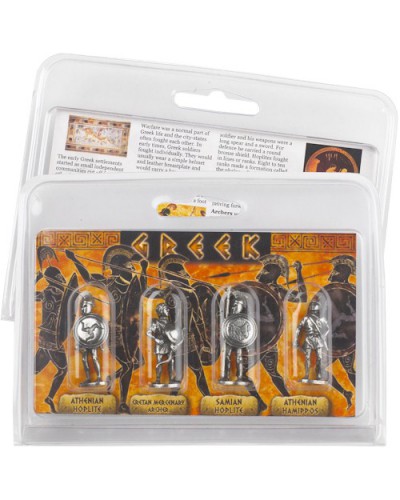Product Description: This set of 4 Greek Warrior figures, each measuring 4cm tall, are made from lead-free pewter. The four different warriors in the pack are Athenian Hoplite, Cretan Archer, Samian Hoplite, Athenian Hamippos. The supplied information card is full colour with an image of Greek warriors fighting, taken from a Greek vase, on the front. It has historical information on the reverse, together with images of Greek warriors. The figures and card are held in a clear clam-shell pack.
Information: The early Greek settlements started as small independent communities cut off from each other by terrain and aften competing for the best farming land. As the communities developed the became city-states each with their own strong individual identity. Each city-state has its own government. Sometimes the city-states fought one another, sometimes they joined together. Athens, Sparta, Corinth and Olympia were four of the largest city-states.
Warfare was a normal part of Greek life and the city-states often fought each other. In early times, Greek soldiers fought individually. They would usually wear a simple helmet and leather breastplate and would carry a bronze tipped spear and a sword as weapons.
At the turn of the 5th century the backbone of the Greek army was the Hoplite. He was a foot soldier, and his weapons were a long spear and a sword. For defence he carried a round bronze shield. Hoplites fought in lines or ranks. Eight to ten ranks made a formation called the phalanx. Each soldier held his long spear underarm. Enemy soldiers saw only a mass of spears and shields, that was hard to break through - and hard to stop once it started moving forward.
Archers were used in Greek warfare from the earliest times. However Greek armies concentrated on soldiers of the phalanx, and archery was neglected, except in Crete. Archers carried bows and arrows as well as a sword and small shield. Archers in Greek armies were therefore often mercenaries, usually Scythians or Cretans.
The Hamippoi were lightly armed infantry trained to fight alongside the cavalry. They would go into battle holding on the tails of the horses. The Hamippoi were particularly useful in a straight cavalry fight, when they would hack at the enemy horsemen with their swords.

